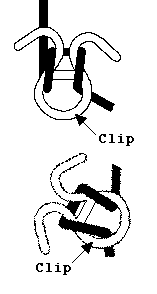Overview
[ Top
| Longhorn, Version B
| Eighthorn, Version A
| Eighthorn, Version B
| Return to Horns
]
Longhorn,
Version A
(#355)
Technical Details
I acquired this descender from Pathfinder Sports in Tucson,
Arizona in 1979.
My MSR Longhorn,
Version A is 133 mm. tall, 132 mm. wide, 13 mm. thick, and weighs 146 g.
The M.S.R. Longhorn is made from two pieces of half-inch (12.7 mm. ) aluminum rod. The first piece is approximately 430 mm. long
and bent into the shape of an inverted Greek letter omega. The
second piece is about 40 mm. long and welded somewhat off-center
inside the loop of the omega. The ends of the first rod are well-rounded.
The M.S.R. Longhorn is anodized black. The center rod is stamped
with "MSR" on one side and "PAT APP #782437"
on the other.
 The
Longhorn was invented as a replacement for the figure
eight descender. It provides about the same amount of friction
as the typical eight, but can be
rigged and derigged in the standard configuration without unclipping
the device from one’s seat harness. This may help reduce the risk
of dropping the device down a drop, but my experience shows that
some people will manage to drop things no matter how well tied
in they are.
The
Longhorn was invented as a replacement for the figure
eight descender. It provides about the same amount of friction
as the typical eight, but can be
rigged and derigged in the standard configuration without unclipping
the device from one’s seat harness. This may help reduce the risk
of dropping the device down a drop, but my experience shows that
some people will manage to drop things no matter how well tied
in they are.
The Longhorn has many of the same advantages and disadvantages
as the eights. On the positive side,
the Longhorn is light-weight and simple. On the other hand, it
is too large for a constant friction device, it has a low heat
capacity, it tends to spin the rappeller, and there is no way
to continuously vary friction on rappel. Since the Longhorn is
a one-piece device, the entire device must be replaced when the
rope grooves wear too deeply. Some people have managed to accidentally
lock off a figure eight; it is nearly
impossible to do the same thing with a Longhorn.
There are two basic methods used to rig a Longhorn The original
method, shown in the top figure, is perhaps the most obvious.
The bottom figure shows the improved method, which introduces
less spin then the upper method. Both figures are shown from the
rappeller’s viewpoint, and assume the right hand is the braking
hand.
The Longhorn is bulkier than most eights,
and offers no real advantage, so I seldom use mine.
[ Top
| Longhorn, Version A
| Eighthorn, Version A
| Eighthorn, Version B
| Return to Horns
]
Longhorn,
Version B
(#3041)
Technical Details
I acquired my MSR Longhorn, Version B from Marty Karabin in 2021.
This Longhorn is 135 mm. tall, 131 mm. wide, 15 mm. thick, and weighs 149 g.
The center rod is stamped
with "MSR" on one side.
Unlike Version A, Version B is unfinished.
[ Top
| Longhorn, Version A
| Longhorn, Version B
| Eighthorn, Version B
| Return to Horns
]
Eighthorn,
Version A
(#354)
Technical Details
I acquired this descender from Pathfinder Sports in 1978. I
had tried to obtain the device directly from Mountain Safety Research,
but apparently it was only in production for a very limited time.
The Eighthorn is made from a single 60 mm. piece of 11 mm. aluminum
rod bent into the shape of a figure
eight with two horns at the base. There is a substantial weld
in the waist area that serves to keep the rope from jamming between
the two rod segments in this area. This weld is built up to contribute
significantly to the final shape of the device in the waist area.
Another weld at the bottom keeps the attachment eye closed.
There are no marks on this Eighthorn.
The Eighthorn can be used as either a longhorn (inverted, as in the photo) or a figure
eight. When used as a longhorn, it behaves almost identically
to the M.S.R. Longhorn. When used as an eight,
it behaves like any other eight
except the horns get in the way. I view the Eighthorn as a novelty
item for people who can't make decisions because it does not offer
any advantage over either the Longhorn or the eight.
The manufacturing quality control on my Eighthorn was acceptable,
but not outstanding. The ends of the horns are not rounded (they
have an insignificant bevel instead). The welds on my Eighthorn
are sloppy, but there are no pits or sharp edges. I repeat my
objections to welds in aluminum; however, there is sufficient
undisturbed base metal in the Eighthorn that I am not too concerned
about strength loss from the welds.
[ Top
| Longhorn, Version A
| Longhorn, Version B
| Eighthorn, Version A
| Return to Horns
]
Eighthorn,
Version B
(#2454)
Technical Details
I acquired my MSR Eighthorn, Version B from Donald Buchanan in 2017.
Version B is 143 mm. tall, 166 mm. wide, 22 mm. thick, and weighs 144 g.
There are no marks on this Eighthorn.
Unlike Version A, Version B is unfinished.
[ Top
| Longhorn, Version A
| Longhorn, Version B
| Eighthorn, Version A
| Eighthorn, Version B
]



 The
Longhorn was invented as a replacement for the
The
Longhorn was invented as a replacement for the